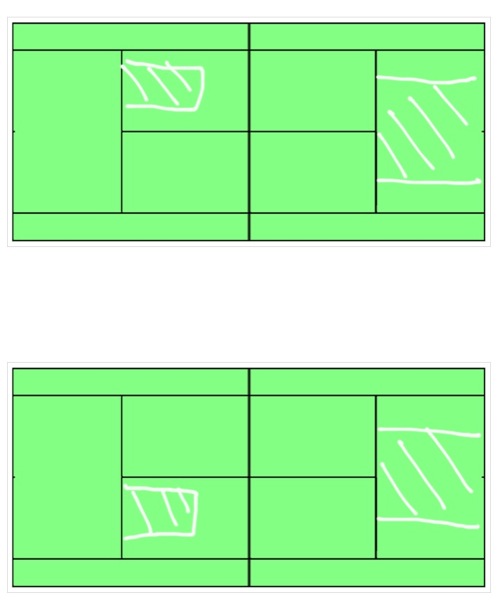Returning Against a Serve and Volleyer
 Wednesday, November 30, 2011 at 09:33AM
Wednesday, November 30, 2011 at 09:33AM  CAtennis
CAtennis  Not many players favor the serve-and-volley game style in the modern game of tennis. Accordingly, facing such a player can be very frustrating sometimes unless you have a great deal of experience under your belt. Here are some things to keep in mind when facing a net rusher:
Not many players favor the serve-and-volley game style in the modern game of tennis. Accordingly, facing such a player can be very frustrating sometimes unless you have a great deal of experience under your belt. Here are some things to keep in mind when facing a net rusher:
1. Make him volley. This may seem like routine advice, but that's not quite the case. A S-V player provokes the following unconscious thoughts in your mind: A) he's coming in; B) he's coming in because he likes it; C) if he likes it, he must be good at it; and D) if he's good at it, I better keep the ball away from him. This is exactly the way the net rusher wants you to think; he wants to tempt you to go for the low percentage passing shot off his major weapon. It's hard enough to pass someone who is coming in off a ground stroke! Why would you try to do this off a serve?! Therefore, a better tactic would be to make the player volley and see what tools he has on his belt. Maybe it's all just a bluff! You will never know unless you test him.
2. Your point of recovery following the return should be inside the baseline. The good serve a volleyers will attempt to combine good serves with sharp angles. For them, this guarantees that the returner has the most ground to cover. Therefore, returning and then recovering deep behind the baseline's center-T plays right into their hand. You want to recover in an aggressive position in order to ensure that you are as close to the next shot as possible. Force them to aim their volleys deep - not only may this draw errors but it will also reduce the angles that they can create.
3. Don't forget about the chip return (NOT a slice). Depending on how solid your chip return is (if it's not, try to improve it), a chip return may give you a better option if you're unsure of your opponent's tendencies. For one, the chip requires little or no back-swing (you're utilizing the opponent's pace and only redirecting the shot) so you can make the decision on where to hit and how deep much later (in terms of tennis-time). Also, the chip requires a continental grip so if you have a one-handed backhand, it's easier to transition from the forehand grip (Western or Semi-Western) to the chip (since you only have to go half-way). In addition, a chip has a completely different spin - something that the volleyer may have difficulty handling. A topspin ball dips into the volleyer's string-bed. A well-struck chip will "pop up" of his strings - thereby forcing the volleyer to make adjustments. Volleyers are more accustomed to volleying against a topsin than against a ball that spins the "other way".
4. Stay close in. Similar to playing a big-bomber, it's important to stay closer to the court when returning and thereby position yourself so as to cut off the server's angles. Most likely, the serve and volleyer will attempt to come in off a spin serve (kick, topspin, or slice) in order to give himself more time to close in. If you stay back, you will allow him to take an extra couple of steps - at which point, it will be difficult to make him volley below the net (your goal is to make him pop up the volley as opposed to sticking it downwards). Stay close in, use the pace of his serve (even a kick-serve has sufficient pace for you to use and redirect) and seek to make the rusher volley behind the center-T or half-volley around the center-T.
The center-T should be your target in these instances. Pound it incessantly and force the volleyer to generate angles from the middle of the court; don't give him an opening (i.e. too far away from the middle but within reach) from which he can generate an angle. Unless he's very, very good, chances are that he will have difficulty handling these shots. The best return is, actually, slightly cross-court from your return position - this force the opponent to adjust the face the face of the racket and to generate a slight "inside-out" angle. For example, if you're returning from the deuce side down-the-line, the opponent can stick a cross-court backhand volley without much difficulty. Return cross-court, and he will have problems generating the same angle with his forehand volley down-the-line.
5. Attack. Another oft-forgotten play is to come in yourself (chip-and-charge). This may work as a great surprise-tactic since the server expects to face an opponent who is staying deep. You have a slight advantage in these situations because out of the two players, you're the only one who knows what to expect. Depending on the serve, you may in fact "beat the player" to the net since, the ball would have reached your position a split second after the server's contact with the ball. Chip down the T (low), rush in and pounce on the opponent's next shot (particularly any pop-up floaters). Stun him once or twice and you will either force him to do more with his serves (resulting in more double faults or second serves; [DING-DING] BONUS) or his volleys (errors). If you're lucky, you might actually force him to stay back ([DING-DING] DOUBLE BONUS) and that's when you know that you have really rocked his boat.



